Prince William Henry, Duke of Gloucester and Edinburgh
| Prince William | |||||
|---|---|---|---|---|---|
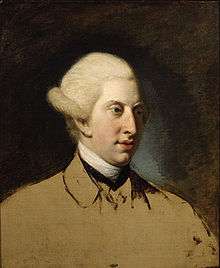 Portrait by Johan Zoffany, c. 1780 | |||||
| Duke of Gloucester and Edinburgh | |||||
| Successor | Prince William Frederick | ||||
| Born |
25 November 1743 Leicester House, Westminster | ||||
| Died |
25 August 1805 (aged 61) Gloucester House, Westminster | ||||
| Burial |
4 September 1805 St George's Chapel, Windsor | ||||
| Spouse | Maria Walpole | ||||
| Issue |
Princess Sophia Princess Caroline Prince William Frederick | ||||
| |||||
| House | Hanover | ||||
| Father | Frederick, Prince of Wales | ||||
| Mother | Princess Augusta of Saxe-Gotha | ||||
Prince William, Duke of Gloucester and Edinburgh, KG PC FRS (William Henry; 25 November 1743 – 25 August 1805), was a grandson of King George II and a younger brother of King George III of the United Kingdom.
Life
Youth
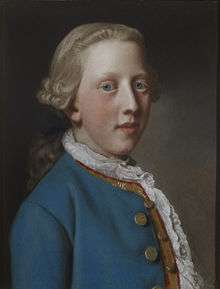
Prince William Henry was born at Leicester House, London. His parents were Frederick, Prince of Wales, eldest son of George II and Caroline of Ansbach, and Princess Augusta of Saxe-Gotha, then Princess of Wales. He was christened at Leicester House eleven days later. His godparents were his paternal uncle by marriage, the Prince of Orange (for whom someone stood proxy); his paternal uncle, the Duke of Cumberland; and his paternal aunt, Princess Amelia.[1] As a grandchild of the sovereign, he was styled His Royal Highness Prince William at birth. He was fourth in the line of succession at birth.
His father died in 1751, leaving the Prince's elder brother, Prince George, heir-apparent to the throne. He succeeded as George III on 25 October 1760, and created William Duke of Gloucester and Edinburgh and Earl of Connaught on 19 November 1764.[2] He had been made a Knight of the Garter on 27 May 1762, and invested on 22 September of that year.[3] In 1764 he began to court Maria Walpole, the Dowager Countess of Waldegrave, an illegitimate granddaughter of Sir Robert Walpole.[4]
Career and marriage
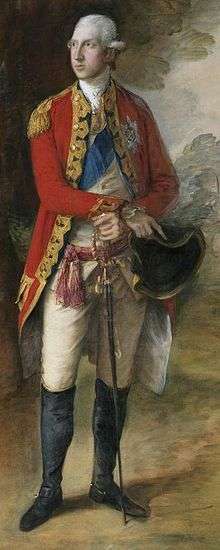
He initially wished for active service in the military, but his health and intelligence both proved insufficient. Instead he was appointed colonel of the 13th Regiment of Foot in 1766. That same year he and Maria married in secret in his home on Pall Mall. This marriage only became known to the King after the passing of the Royal Marriages Act 1772. The Duke and Maria lived at St Leonard's Hill in Clewer, near Windsor and had three children, all of whom were styled Highness from birth and used the territorial designation of Gloucester in conjunction with their princely styles, as great-grandchildren in the male line of George II.
In 1767 he was promoted to major-general and made colonel of the 3rd Regiment of Foot Guards.[6] The same year he was made Warden of Windsor Forest, gaining the post's official residence at Cranbourne Lodge[7] He was made the thirteenth Chancellor of Trinity College, Dublin in 1771, holding the post until 1805.
The Duke and Maria's first child Princess Sophia of Gloucester (Sophia Matilda; 29 May 1773 – 29 November 1844) was born in 1773. Princess Caroline of Gloucester (Caroline Augusta Maria; 24 June 1774 – 14 March 1775) followed just over a year later and was christened privately on 22 July 1774 - her godparents were the Duchess of Gloucester (her mother), the Hereditary Duchess of Brunswick-Lüneburg (her paternal aunt) and the Hereditary Duke of Brunswick-Lüneburg (her uncle by marriage).[1] However, Princess Caroline died aged just nine months following a smallpox inoculation, intended to protect her from the disease.[8] The Duke and Maria had a third and final child in 1776, Prince William Frederick (15 January 1776 – 30 November 1834).
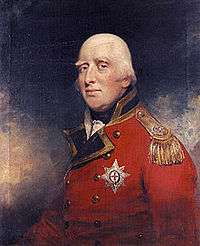
With the outbreak of the American Revolutionary War, the Duke hoped for a field command, but George refused. He made a request to serve in the forces of Prince Frederick of Prussia during the War of Bavarian Succession (1777–1779) - George consented but Prince Frederick himself turned down the offer. He later transferred to the 1st Regiment of Foot Guards, and he became a field marshal on 18 October 1793.[9] He went on to be General Officer Commanding Northern District in 1796,[10] a command that he held until 1802.[11]
Later life
In 1782 an illegitimate daughter was born to the Duke, Louisa Maria La Coast (6 January 1782 Esher, Surrey – 10 February 1835 Bossall, Yorkshire). Her mother was the Duke's mistress Lady Almeria Carpenter, a daughter of the first Earl of Tyrconnell.[12]
Louisa was married on 29 December 1803 in Norwich, Norfolk to Godfrey Macdonald, 11th Baronet Macdonald of Slate, later the 3rd Baron Macdonald of Slate. They had three children born before their marriage (legitimized by Scottish law, but not by Irish law) and ten children born after their marriage. (A previous marriage in Scotland was considered of doubtful validity.) These children and their posterity are the only descendants of Prince William, 1st Duke of Gloucester and Edinburgh. The Duke died at Gloucester House in London in 1805 and was succeeded as duke by his son William Frederick, who went on to marry his cousin Princess Mary in 1816, meaning that he and Sophia then received the style of Royal Highness.
Titles, styles, honours and arms
Titles and styles
- 25 November 1743 – 19 November 1764: His Royal Highness Prince William[13]
- 19 November 1764 – 25 August 1805: His Royal Highness The Duke of Gloucester and Edinburgh
His peerages were gazetted on 17 November 1764.[14]
Honours
- 27 May 1762: Knight of the Garter (KG)
- Privy Counsellor (PC)
- Royal Fellow of the Royal Society (FRS)
Arms
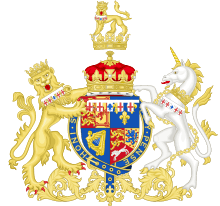
William was granted use of the arms of the kingdom, differenced by a label argent of five points, the centre bearing a fleur-de-lys azure, the other points each bearing a cross gules.[15]
Ancestors
References
- 1 2 Yvonne's Royalty Home Page: Royal Christenings
- ↑ Yvonne's Royalty: Peerage
- ↑ The London Gazette: no. 10247. p. 1. 25 September 1762.
- ↑ Oxford Dictionary of National Biography - Prince William Henry, Duke of Gloucester and Edinburgh
- ↑ The portrait remained in his studio unfinished on his death, before being bought by the Prince Regent for the Duke's eldest daughter, Sophia. It is now in the collection of the National Army Museum.
- ↑ The London Gazette: no. 10796. p. 3. 5–9 January 1768. Retrieved 13 July 2014.
- ↑ Jane Roberts, Royal Landscape: The Gardens and Parks of Windsor, page 50.
- ↑ Berkshire History: Biographies: Maria Walpole, Duchess of Gloucester (1737-1807)
- ↑ The London Gazette: no. 13582. p. 913. 15 October 1793. Retrieved 13 July 2014.
- ↑ Mackenzie, Eneas (1827). "Historical events: 1783 - 1825, in Historical Account of Newcastle-Upon-Tyne Including the Borough of Gateshead". Newcastle-upon-Tyne. pp. 66–88. Retrieved 18 December 2015.
- ↑ Baines, Edward (1825). "History, Directory, and Gazetteer, of the County Palatine of Lancaster". William Wales & Co. p. 15.
- ↑ Charles Watkins; Ben Cowell (2012). Uvedale Price (1747-1829): Decoding the Picturesque. Boydell Press. pp. 36–37. ISBN 978-1-84383-708-4.
- ↑ The London Gazette calls him "His Royal Highness Prince William" The London Gazette: no. 10212. p. 2. 25 May 1762.; The London Gazette: no. 10247. p. 1. 25 September 1762.; The London Gazette: no. 10411. p. 1. 21 April 1764.
- ↑ The London Gazette: no. 10470. p. 1. 17 November 1764.
- ↑ Marks of Cadency in the British Royal Family
External links
- Wikiquotes of Edward Gibbon, for the Duke's remark on The History of the Decline and Fall of the Roman Empire
- Royal Berkshire History: Prince William Henry, Duke of Gloucester
| Prince William Henry, Duke of Gloucester and Edinburgh Cadet branch of the House of Welf Born: 14 November 1743 Died: 25 August 1805 | ||
| Military offices | ||
|---|---|---|
| Preceded by Sir William Howe |
GOC Northern District 1796–1802 |
Succeeded by Sir Hew Dalrymple |
| Preceded by Harry Pulteney |
Colonel of the 13th Regiment of Foot 1766–1767 |
Succeeded by James Murray |
| Preceded by The Earl of Rothes |
Colonel of the 3rd Regiment of Foot Guards 1767–1770 |
Succeeded by The Earl of Loudoun |
| Preceded by The Earl Ligonier |
Colonel of the 1st Regiment of Foot Guards 1770–1805 |
Succeeded by The Duke of York and Albany |
| Peerage of Great Britain | ||
| New creation | Duke of Gloucester and Edinburgh 1764–1805 |
Succeeded by Prince William Frederick |
| Peerage of Ireland | ||
| New creation | Earl of Connaught 1764–1805 |
Succeeded by Prince William Frederick |
.svg.png)